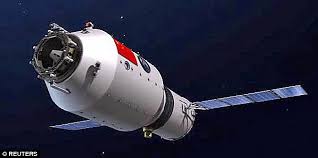By Katie Hunt, CNN
Hong Kong (CNN) China’s Tiangong-1 space lab was billed as a potent symbol of the country’s rise when it launched in 2011.
Now, the lab is out of control and expected to crash-land on Earth by the end of March — posing a minuscule risk to humans but inflicting a blot on the nation’s bold push to become a space superpower.“They have a PR embarrassment on their hands,” said Jonathan McDowell, an astrophysicist at the Harvard-Smithsonian Center for Astrophysics. “The actual danger is small, but it is accepted international best practice nowadays that objects that big shouldn’t be able to fall out of the sky in this manner.”
Space experts stress the potential danger to humans is minimal — the odds of debris from the vessel hitting a human are astronomically tiny, estimated to be less than one in 1 trillion. That compares with a one-in-1.4 million chance of a person in the US being struck by lightning.
In the best-case and most likely scenario, the space lab will largely burn up as it enters Earth’s atmosphere over the ocean and a few parts will sink to the seafloor.
“The worst realistic case is that the Tiangong-1 reenters over a highly populated area, and a few largest chunks hit the ground, with perhaps some minor property damage,” McDowell said. “But this has never happened in the 60-year history of re-entering space debris. The chances are small.”
Tiangong-1 stops functioning
The 8.5-ton, 40-foot Tiangong-1, or “Heavenly Palace,” was launched in September 2011. Along with its successor — the Tiangong-2, which launched in 2016 — it was a prototype for China’s ultimate space goal: a permanent, 20-ton space station that is expected to launch around 2022.
It’s part of ambitious space plans that also include putting a man on the moon and sending a rover to Mars.
The Tiangong-1 was last used by astronauts in 2013.
“The original plan was for it to be retired soon after and sent under control into the ocean, but they were worried that its successor, Tiangong-2, might not get into orbit successfully, so they decided to keep the Tiangong-1 around as a backup,” McDowell said.
But Tiangong-1 “ceased functioning” on March 16, 2016, China told the United Nations in May, without specifying why.
China may have lost control of the lab because it ran out of fuel, said Roger Handberg, a professor at the University of Central Florida.
Six months after Tiangong-1 went offline, Tiangong-2 went into orbit successfully.
“While the Chinese would have, of course, preferred this event not to happen, this does not present a threat to their long-term human spaceflight plans,” said Joan Johnson-Freese, a professor and former chair of national security affairs at the US Naval War College in Rhode Island. – CNN




